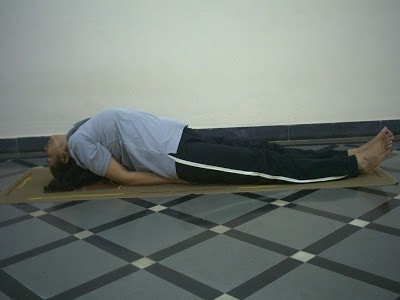By: Dr Rita Khanna
Yogic Approach to thyroid

Thyroid is one of the larger endocrine glands in the body. It is located in the neck and produces hormones, principally T4 (thyroxin) and T3 (tri-iodo-thyronin) that regulate the rate of metabolism and affect the growth and rate of function of many other systems in the body. When the thyroid gland functions lesser than required, this condition is called hypo-thyroidism. However if thyroid works more than required amount that condition is known as hyper-thyroidism. When the gland works properly, it is known as euthyroidism. The thyroid gland depends on supply of iodine for manufacture of hormones.
SYMPTOMS
Symptoms of hypo-thyroidism disorder are overweight, lethargy, loss of hair, scaling away of the skin, swelling in parts of the body, the body suddenly getting cold, changes in hunger pattern etc. People with this disorder should avoid cabbage & lady finger. Symptoms of hyper-thyroidism disorder are nervous tension, an increased mental activity, uncontrollable body movements, an increase in heartbeat & pulse rate, excessive sweating, loss of weight & jutting out of eyeballs in certain cases. People with this disorder should eat more of cabbage & lady finger.
YOGA & THYROID
Regular Yoga practice & Pranayama help to nourish & balance the thyroid by bringing fresh oxygenated blood into the area & flushing out old blood & toxins. In Yoga, the practices of Ujjayi Pranayama & Matsyasana have had beneficial effects on the thyroid. While doing these two practices, focus your mind on the throat, the effects will be more. If you are not confident of any of the exercises, please ask your instructor for guidance.
MATSYASANA / FISH POSE
In this posture, we get pressure on the neck. It works & energizes the thyroid gland, strengthens the abdomen and opens your throat chakra. Metabolism balances and immune system is boosted.
TECHNIQUE
Lie on your back on the floor with your knees bent.
Inhale, lift your hips slightly off the floor, and put your hands under your tailbone with your palms facing the floor, your thumbs touching each other.
Now rest your buttocks on the backs of your hands (don’t lift them off your hands as you perform this pose). Try to adjust your forearms and elbows under the spine properly.
While pressing your forearms and elbows firmly against the floor, inhale, draw your head backward and place the top of the head on the floor.
Deepen the arch by lifting the chest up.
Your weight should rest on your elbows. There should be a minimal amount of weight on your head.
Breathe normally all the while, keeping your legs and lower torso relaxed.
To come out of the pose, exhale, lift your head and place it gently back down, then release the arms.
UJJAYI PRANAYAMA
Ujjayi Pranayama stimulates thyroid gland to work normally.
SITTING POSTURE
Sit in any comfortable posture with the spine, head & neck in one straight line. You can keep your hands on the knees in Gyan Mudra Posture (join the tips of the index fingers to the tips of the thumbs while keeping the other fingers extended & loose). Close your eyes gently & relax all the muscles. Spend a few moments being aware of your natural breath as it passes in and out of the nose.
TECHNIQUE
· Closing the mouth, slowly draw in air through both the nostrils producing a sound in such a way that while inhaling the touch of air is felt in the throat to the chest. The sound is as if wind blows with pressure. The sound should be uniform and continuous.
· It means that after inhaling the breath through the nose, the passage of the incoming air is felt on the roof of the palate first, then towards the throat (bring your mind to the throat and feel the contraction in the throat), after that to the lungs. Then fill the lungs up to the brim.
· During inhalation, do not allow abdomen to bulge out, let the chest expand.
· After completing inhalation, slowly exhale. During exhalation chest should go inside and abdomen should remain steady.
· While exhaling, the passage of the outgoing air should be felt on the roof of the palate.
· The process described above completes one cycle of Ujjayi Pranayama.
· Repeat the cycles for five to 10 minutes keeping the eyes closed.
· With each breath say to yourself mentally that I am getting improvement
· Then lie on the floor for Shavasana.
· Ujjayi Pranayama can also be done while lying down on the floor. This pranayama can be done at any time of the day and night.
· After practising it for few days, knowing your limitations, keep the ratio between inhalation and exhalation 1: 2.
The three-pronged approach of Yoga-abhyasa, a specialist Doctor’s advice and positive frame of mind will cure your Thyroid complications completely & you’ll get a boon of perfect, happy and composed health.




